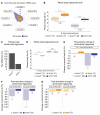A role for triglyceride lipase brummer in the regulation of sex differences in Drosophila fat storage and breakdown
- PMID: 31961851
- PMCID: PMC6994176
- DOI: 10.1371/journal.pbio.3000595
A role for triglyceride lipase brummer in the regulation of sex differences in Drosophila fat storage and breakdown
Abstract
Triglycerides are the major form of stored fat in all animals. One important determinant of whole-body fat storage is whether an animal is male or female. Here, we use Drosophila, an established model for studies on triglyceride metabolism, to gain insight into the genes and physiological mechanisms that contribute to sex differences in fat storage. Our analysis of triglyceride storage and breakdown in both sexes identified a role for triglyceride lipase brummer (bmm) in the regulation of sex differences in triglyceride homeostasis. Normally, male flies have higher levels of bmm mRNA both under normal culture conditions and in response to starvation, a lipolytic stimulus. We find that loss of bmm largely eliminates the sex difference in triglyceride storage and abolishes the sex difference in triglyceride breakdown via strongly male-biased effects. Although we show that bmm function in the fat body affects whole-body triglyceride levels in both sexes, in males, we identify an additional role for bmm function in the somatic cells of the gonad and in neurons in the regulation of whole-body triglyceride homeostasis. Furthermore, we demonstrate that lipid droplets are normally present in both the somatic cells of the male gonad and in neurons, revealing a previously unrecognized role for bmm function, and possibly lipid droplets, in these cell types in the regulation of whole-body triglyceride homeostasis. Taken together, our data reveal a role for bmm function in the somatic cells of the gonad and in neurons in the regulation of male-female differences in fat storage and breakdown and identify bmm as a link between the regulation of triglyceride homeostasis and biological sex.
Conflict of interest statement
The authors have declared that no competing interests exist.
Figures







Similar articles
-
An important role for triglyceride in regulating spermatogenesis.Elife. 2024 May 28;12:RP87523. doi: 10.7554/eLife.87523. Elife. 2024. PMID: 38805376 Free PMC article.
-
Dual lipolytic control of body fat storage and mobilization in Drosophila.PLoS Biol. 2007 Jun;5(6):e137. doi: 10.1371/journal.pbio.0050137. PLoS Biol. 2007. PMID: 17488184 Free PMC article.
-
Brummer lipase is an evolutionary conserved fat storage regulator in Drosophila.Cell Metab. 2005 May;1(5):323-30. doi: 10.1016/j.cmet.2005.04.003. Cell Metab. 2005. PMID: 16054079
-
The role of adipose triglyceride lipase in lipid and glucose homeostasis: lessons from transgenic mice.Lipids Health Dis. 2019 Nov 22;18(1):204. doi: 10.1186/s12944-019-1151-z. Lipids Health Dis. 2019. PMID: 31757217 Free PMC article. Review.
-
Adipose tissue lipolysis as a metabolic pathway to define pharmacological strategies against obesity and the metabolic syndrome.Pharmacol Res. 2006 Jun;53(6):482-91. doi: 10.1016/j.phrs.2006.03.009. Epub 2006 Mar 27. Pharmacol Res. 2006. PMID: 16644234 Review.
Cited by
-
Peppers in Diet: Genome-Wide Transcriptome and Metabolome Changes in Drosophila melanogaster.Int J Mol Sci. 2022 Sep 1;23(17):9924. doi: 10.3390/ijms23179924. Int J Mol Sci. 2022. PMID: 36077322 Free PMC article.
-
Spenito-dependent metabolic sexual dimorphism intrinsic to fat storage cells.Genetics. 2023 Nov 1;225(3):iyad164. doi: 10.1093/genetics/iyad164. Genetics. 2023. PMID: 37738330 Free PMC article.
-
Physiological and metabolomic consequences of reduced expression of the Drosophila brummer triglyceride Lipase.PLoS One. 2021 Sep 21;16(9):e0255198. doi: 10.1371/journal.pone.0255198. eCollection 2021. PLoS One. 2021. PMID: 34547020 Free PMC article.
-
An important role for triglyceride in regulating spermatogenesis.Elife. 2024 May 28;12:RP87523. doi: 10.7554/eLife.87523. Elife. 2024. PMID: 38805376 Free PMC article.
-
Dhr96[1] mutation and maternal tudor[1] mutation increase life span and reduce the beneficial effects of mifepristone in mated female Drosophila.PLoS One. 2023 Dec 21;18(12):e0292820. doi: 10.1371/journal.pone.0292820. eCollection 2023. PLoS One. 2023. PMID: 38127988 Free PMC article.
References
Publication types
MeSH terms
Substances
Grants and funding
LinkOut - more resources
Full Text Sources
Molecular Biology Databases

